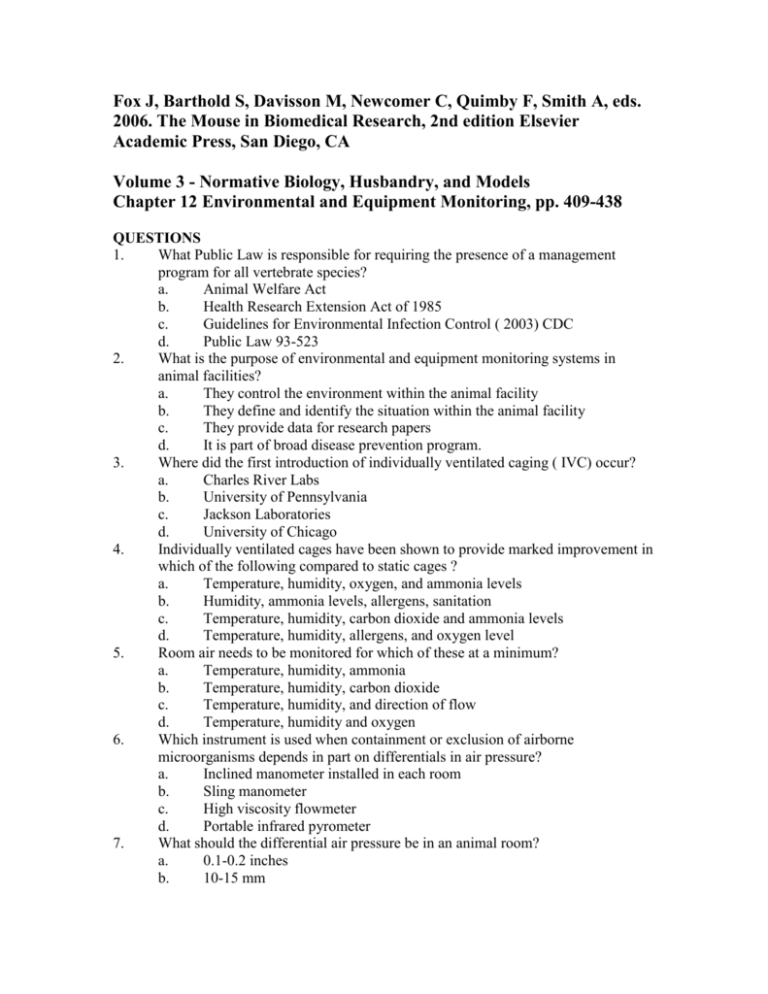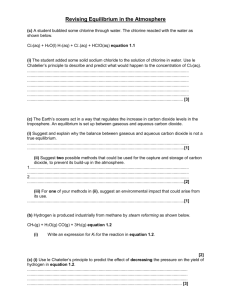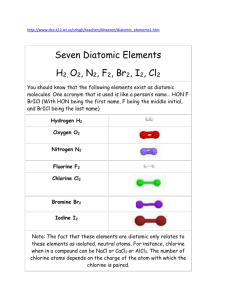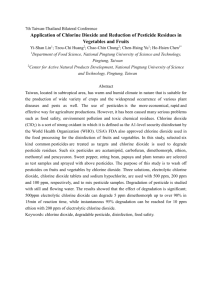Chapter 12: Environmental and Equipment Monitoring
advertisement

Fox J, Barthold S, Davisson M, Newcomer C, Quimby F, Smith A, eds. 2006. The Mouse in Biomedical Research, 2nd edition Elsevier Academic Press, San Diego, CA Volume 3 - Normative Biology, Husbandry, and Models Chapter 12 Environmental and Equipment Monitoring, pp. 409-438 QUESTIONS 1. What Public Law is responsible for requiring the presence of a management program for all vertebrate species? a. Animal Welfare Act b. Health Research Extension Act of 1985 c. Guidelines for Environmental Infection Control ( 2003) CDC d. Public Law 93-523 2. What is the purpose of environmental and equipment monitoring systems in animal facilities? a. They control the environment within the animal facility b. They define and identify the situation within the animal facility c. They provide data for research papers d. It is part of broad disease prevention program. 3. Where did the first introduction of individually ventilated caging ( IVC) occur? a. Charles River Labs b. University of Pennsylvania c. Jackson Laboratories d. University of Chicago 4. Individually ventilated cages have been shown to provide marked improvement in which of the following compared to static cages ? a. Temperature, humidity, oxygen, and ammonia levels b. Humidity, ammonia levels, allergens, sanitation c. Temperature, humidity, carbon dioxide and ammonia levels d. Temperature, humidity, allergens, and oxygen level 5. Room air needs to be monitored for which of these at a minimum? a. Temperature, humidity, ammonia b. Temperature, humidity, carbon dioxide c. Temperature, humidity, and direction of flow d. Temperature, humidity and oxygen 6. Which instrument is used when containment or exclusion of airborne microorganisms depends in part on differentials in air pressure? a. Inclined manometer installed in each room b. Sling manometer c. High viscosity flowmeter d. Portable infrared pyrometer 7. What should the differential air pressure be in an animal room? a. 0.1-0.2 inches b. 10-15 mm 8. 9. 10. 11. 12. 13. 14. c. 0.1-.02 mm d. 10-15 inches As air filters become dirty they a. Become less efficient at filtering out particulate air, and the volume of the air passing through the filter per unit time increases b. Become more efficient at filtering out particulate air, but the volume of air passing through the filter per unit time decreases. c. Become less efficient at filtering out particulate air, and the volume of the air passing through the filter per unit time decreases d. Decrease the volume of air passing through the filter but have no impact on the efficiency of filtering the particulate air All of the following can be used for monitoring the air for microbial content except? a. Settling plates b. Andersen Cascaded Sieve Sampler c. Liquid impingers d. Microairomatic processor NRC recommends what level of light for rodent rooms? a. 325 footcandles at 1 meter above floor b. 30 lux at 1 meter above the floor c. 325 lux at 1 meter above floor d 30 footcandles at 1 foot above the floor Retinal atrophy is more common in mice: a. Located at the bottom of the racks b. Located at the top of the racks c Location doesn’t matter d. When they are first weaned When mice are kept in red light longer than blue, yellow or green light, which of the following are seen? a. Estrous cycle longer and estrous phase shorter b. estrous cycle shorter and estrous phase shorter c. Estrous cycle longer and estrous phase shorter d. Estrous cycle longer and estrous phase longer Increase noise intensity can bother humans and mice, what is the mechanism for this? a. Sensitive pain receptors in the ear b. Anterior pituitary acting on the adrenal gland, effects are associated with increased levels of corticosteroids and epinephrine c. Central pain receptors in hippocampus d. Anterior pituitary acting on the adrenal gland, effects are associated with decreased levels of corticosteroids and epinephrine It has been recommended that areas housing mice be surveyed every few years or when a significant change in physical or mechanical structure takes place. There is a concern when the testing shows a. Noise levels above 4 Hz and less than 70 dB SPL b. Noise levels below 4 Hz and greater than 70 dB SPL 15. 16. 17. 18. 19. 20. 21. c. Noise levels above 4 Hz and greater than 70 dB SPL d. Noise levels between 4- 32Hz A cage wash quality assurance program should contain at a minimum, which of the three following categories, in addition to visual inspection? a. Time of exposure to and temperature of the wash and final rinse solutions, presence of viable vegetative organisms, pump pressure b. Time of exposure to and temperature of the wash and final rinse solutions, pressure in and function of spray heads, and detergent concentration c. Time of exposure to and temperature of the wash and final rinse solutions, pump pressure, placement of spray nozzles d. Time of exposure to and temperature of the wash and final rinse solutions, examination of temperature and pressure gauges, soil removal Performance recommendations applied to cage washers are taken from studies done on commercial dishwashers for the National Sanitation Foundation. These studies used which bacteria? a. Mycobacterium bovis b. Mycobacterium tuberculosis c. Mycobacterium phlei d. Mycobacterium sterothermophilus Accidental washing of mouse cages made of high temperature polycarbonate in a solution of quaternary ammonium disinfectant results in damage to the cages and leaching of which compound? a. Bisphenol A b. Bisphenol B c. Biphenyl A d. Biphenyl B To acidify drinking water for mice, the ending pH should be a. 3.0-4.0 b. 2.0-3.0 c. 4.0-5.0 d. 1.0-2.0 Increase water consumption has been observed in mice given a. Water with 12 ppm chlorine b. Water with 120 ppm chlorine c. Water with pH of 2.0-3.0 d. Water with pH of 1.0-2.0 Correct pressure for water distribution in a rack manifold with a flush system should be set at a. 3-5 psi at the pressure gauge upstream of the pressure reducer b. 3-5 psi at the pressure gauge downstream of the pressure reducer c. 8-10 psi at the pressure gauge downstream of the pressure reducer d. 8-10 psi at the pressure gauge upstream of the pressure reducer All of the following are reasons why ethylene oxide is being used less for sterilizing heat sensitive instruments except one a. Highly flammable b. Explosive when mixed with air c. d. 22. 23. 24. 25. 26. Long exposure time followed by degassing Exposure of personnel to EtO must be monitored and records retained for 20 years Disinfectants are classified under Federal law as a. Antimicrobial pesticides and regulated by the USDA b. Antimicrobial pesticides and regulated by the FDA c. Antimicrobial pesticides and regulated by the Animal Welfare Act d. Antimicrobial pesticides and regulated by the EPA What should be used to select the class of disinfectant-detergent use in the vivarium? a. Quaternary ammonia compounds first b. Professional judgment c. Best price from vendor d. Disinfectants/detergents with a nice perfume added Formaldehyde gas for high-level decontamination of animal facilities has largely been replaced by a. Ethylene oxide b. Vaporized hydrogen peroxide c. Liquid hydrogen peroxide d. Peroxymonosulfate A key difference between chlorine and chlorine dioxide is a. Chlorine dioxide has antimicrobial activity at a wide range of pH (6-10) compared to chlorine b. Chlorine dioxide is stable in light and chlorine is not c. Chlorine dioxide is safe to breathe and chlorine is not d. Chlorine dioxide can be stored in compressed form and chlorine can not. Peroxymonosulfate (Virkon S) is widely used for disinfecting hard surfaces; it is classified as what kind of agent? a. Iodophor b. Quaternary Ammonium compound c. Substituted Phenol d. Oxidizing Agent ANSWERS: 1. b, page 410 2. b, page 411 3. c, page 412 4. c, page 412 5. c, page 413 6. a, page 413 7. a, page 413 8. b, page 413 9. d, page 412 11. b, page 413 13. b, page 414 14. c, page 414 15. 16. 17. 18 19. 20. 21. 22. 23. 24. 25. 26. b, page 416 c, page 416 a, page 417 b, page 418 a, page 419 b, page420 d, page 422 (records need to be kept for 30 years!) d, page 423 b, page 424 b, page 426 a, page 426 d, page 426






